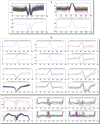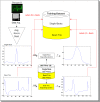Personalized Monitoring and Advance Warning System for Cardiac Arrhythmias
- PMID: 28839215
- PMCID: PMC5571226
- DOI: 10.1038/s41598-017-09544-z
Personalized Monitoring and Advance Warning System for Cardiac Arrhythmias
Abstract
Each year more than 7 million people die from cardiac arrhythmias. Yet no robust solution exists today to detect such heart anomalies right at the moment they occur. The purpose of this study was to design a personalized health monitoring system that can detect early occurrences of arrhythmias from an individual's electrocardiogram (ECG) signal. We first modelled the common causes of arrhythmias in the signal domain as a degradation of normal ECG beats to abnormal beats. Using the degradation models, we performed abnormal beat synthesis which created potential abnormal beats from the average normal beat of the individual. Finally, a Convolutional Neural Network (CNN) was trained using real normal and synthesized abnormal beats. As a personalized classifier, the trained CNN can monitor ECG beats in real time for arrhythmia detection. Over 34 patients' ECG records with a total of 63,341 ECG beats from the MIT-BIH arrhythmia benchmark database, we have shown that the probability of detecting one or more abnormal ECG beats among the first three occurrences is higher than 99.4% with a very low false-alarm rate.
Conflict of interest statement
The authors declare that they have no competing interests.
Figures





References
-
- Mark, R. & Moody, G., MIT-BIH Arrhythmia Database Directory. [Online]. Available: http://ecg.mit.edu/dbinfo.html. - PubMed
-
- Lee, S. C. Using a translation-invariant neural network to diagnose heart arrhythmia, in IEEE Proc. Conf. Neural Information Processing Systems (1989).
MeSH terms
LinkOut - more resources
Full Text Sources
Other Literature Sources
Medical
Research Materials

